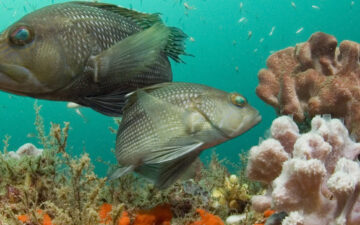By Jake Zadik, a former communications intern with The Ocean Foundation who is now studying in Cuba.
So, you ask, what is a thermoregulating ectotherm? The word “ectotherm” refers to animals that generally have a body temperature comparable to their surrounding environment. They cannot internally regulate their body temperature. People often refer to them as “cold-blooded”, but this term tends to misdirect people more often than not. Ectotherms include reptiles, amphibians, and fish. These animals tend to thrive in warmer environments. Sustained energy output of a warm-blooded (mammal) and a cold-blooded (reptile) animal as a function of core temperature.
“Thermoregulating,” refers to the ability of animals to maintain their internal temperature, with little regard to the temperature. When it is cold outside, these organisms have the ability to stay warm. When it is hot outside, these animals have the ability to cool themselves down and not overheat. These are the “endotherms,” such as birds and mammals. Endotherms have the ability to maintain a constant body temperature and are also referred to as homeotherms.
So, at this point you may realize that the title of this blog is actually a contradiction—an organism that cannot regulate its body temperature but actually has the ability to actively regulate its body temperature? Yes, and it is a very special creature indeed.
This is sea turtle month at The Ocean Foundation, which is why I have chosen to write about the leatherback sea turtle and its special thermoregulation. Tracking research has shown this turtle to have migration routes across oceans, and be constant visitors to a wide array of habitats. They migrate to the nutrient rich, but very cold waters as far north as Nova Scotia, Canada, and have nesting grounds in tropical waters throughout the Caribbean. No other reptile actively tolerates such a wide range of temperature conditions—I say actively because there are reptiles that tolerate below freezing temperatures, but do so in a hibernating state. This has fascinated herpetologists and marine biologists for many years, but it has been more recently discovered that these massive reptiles physically regulate their temperature.
…But they are ectotherms, how do they do this??…
Despite being comparable in size to a small compact car, they do not have the built in heating system that comes standard. Yet their size does play a significant role in their temperature regulation. Because they are so large, leatherback sea turtles have a low surface area to volume ratio, thus the core temperature of the turtle changes at a much slower rate. This phenomenon is called “gigantothermy.” Many scientists believe this was also a characteristic of many large prehistoric animals during the climax of the ice age and it eventually led to their extinction as temperatures began to rise (because they could not cool down fast enough).
The turtle is also wrapped up in a layer brown adipose tissue, a strong insulating layer of fat most commonly found in mammals. This system has the ability to retain more than 90% of heat at the core of the animal, decreasing the heat loss through the exposed extremities. When in high temperature waters, just the opposite occurs. Flipper stroke frequency decreases dramatically, and blood moves freely to the extremities and expels heat through the areas not covered in the insulating tissue.
Leatherback sea turtles are so successful at regulating their body temperature that they have the ability to maintain constant body temperature 18 degrees above or below the ambient temperature. That is so incredible that some researchers argue because this process is metabolically accomplished leatherback sea turtles are actually endothermic. However, this process is not anatomically conducted, therefore most researchers suggest this is a diminutive version of endothermy at best.
Leatherback turtles aren’t the only marine ectotherms to possess this ability. Bluefin tuna have a unique body design that keeps their blood at the core of their body and have a similar counter current heat exchanger system to the leatherback. Swordfish retain heat at their head through a similar insulating brown adipose tissue layer to increase their vision when swimming in deep or cold waters. There are also other giants of the sea that lose heat at a slower process, such as the great white shark.
I think thermoregulation is just one incredibly fascinating characteristic of these beautiful majestic creatures with so much more than meets the eye. From the tiny hatchlings making their way to the water to the ever-ranging males and the returning nesting females, much about them remains unknown. Researchers are unsure where these turtles spend the first few years of their lives. It remains something of a mystery on how these great distance-traveling animals navigate with such precision. Unfortunately we are learning about sea turtles at a rate that is much slower than the rate of their population decline.
In the end it will have to be our determination to protect what we do know, and our curiosity about the mysterious sea turtles that leads to stronger conservation efforts. There is so much unknown about these fascinating animals and their survival is threatened by the loss of nesting beaches, plastic and other pollution in the sea, and accidental bycatch in fishing nets and longlines. Help us at The Ocean Foundation support those who devote themselves to sea turtle research and conservation efforts through our Sea Turtle Fund.
References:
- Bostrom, Brian L., and David R. Jones. “Exercise Warms Adult Leatherback
- Turtles.”Comparative Biochemistry and Physiology Part A: Molecular & Integrative Physiology 147.2 (2007): 323-31. Print.
- Bostrom, Brian L., T. Todd Jones, Mervin Hastings, and David R. Jones. “Behaviour and Physiology: The Thermal Strategy of Leatherback Turtles.” Ed. Lewis George Halsey. PLoS ONE 5.11 (2010): E13925. Print.
- Goff, Gregory P., and Garry B. Stenson. “Brown Adipose Tissue in Leatherback Sea Turtles: A Thermogenic Organ in an Endothermic Reptile?” Copeia 1988.4 (1988): 1071. Print.
- Davenport, J., J. Fraher, E. Fitzgerald, P. Mclaughlin, T. Doyle, L. Harman, T. Cuffe, and P. Dockery. “Ontogenetic Changes in Tracheal Structure Facilitate Deep Dives and Cold Water Foraging in Adult Leatherback Sea Turtles.” Journal of Experimental Biology 212.21 (2009): 3440-447. Print
- Penick, David N., James R. Spotila, Michael P. O’Connor, Anthony C. Steyermark, Robert H. George, Christopher J. Salice, and Frank V. Paladino. “Thermal Independence of Muscle Tissue Metabolism in the Leatherback Turtle, Dermochelys Coriacea.” Comparative Biochemistry and Physiology Part A: Molecular & Integrative Physiology 120.3 (1998): 399-403. Print.







